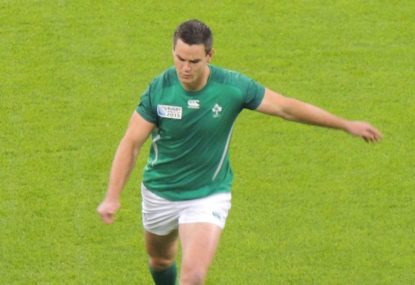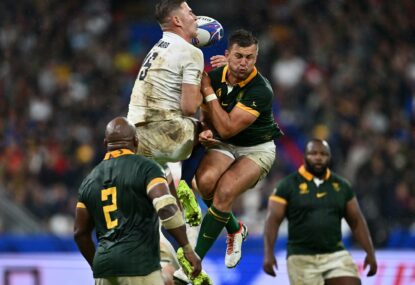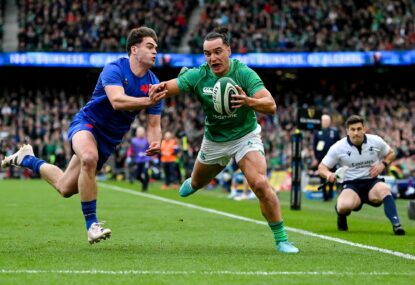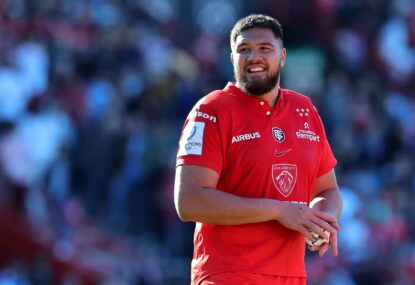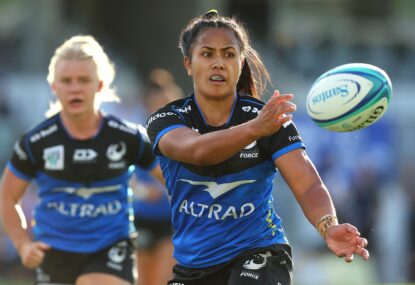England’s clash with Ireland at Twickenham last Saturday was arguably the most entertaining game of the round, with the 21-10 scoreline probably not reflecting how competitive Ireland were for the 80 minutes.
Ireland weathered the storm in the first 40, spending large periods of time scrambling in defence in their own half. Last-ditch tackling prevented what looked like certain scores, and the men in green went to the break only 6-3 down.
As they have done over the last few years, Ireland blitzed the opposition in the third quarter. They began putting width and pace on their attack, dragging England through the phases, and eventually the pressure told when Conor Murray went over for a try in the 46th minute, following clever exploitation of the English fringe defence.
A period of lacklustre Irish defending followed and England scored tries in the 58th and 63rd minutes through Anthony Watson and Mike Brown respectively. Ireland could have been forgiven for folding over at this stage, but they fought back and camped in the English 22, putting Eddie Jones’ team in an uncomfortable position going into the final 15 minutes.
The pressure counted for nothing though, as they weren’t able to execute a number of scoring chances.
Rory Best spent more time in the referee’s ear than in previous games, which benefited Ireland somewhat in the first half. He didn’t have as much influence on the breakdown as normal but he completed seven of eight tackles, comparing favourably to Dylan Hartley, who only managed three completed tackles from seven attempts.
Some of Best’s lineout throwing was off-target and it was all the more frustrating that this happened at crucial moments when Ireland had platforms from which to launch attacks. This was a problem area for the captain a few years ago and for his team’s sake, he cannot let it creep back into his game.
His knock-on in the 14th minute wasted the only visit Ireland had to England’s 22 in the first half. It was a pass that Ireland needed him to catch, and was symptomatic of their high error count over the course of the game.
Jack McGrath formed part of a competent scrummaging unit but he was quiet in the loose when measured against the high standards he set in the previous games. His yards gained after contact were negligible and his tackle count per game has halved since Ireland played Wales.
It’s probably unfair to be critical of him for this drop, as he gets through a staggering amount of work around the park for a prop, but with Cian Healy having little impact off the bench, Ireland could have done with another thundering performance from McGrath.
Mike Ross demonstrated his worth by dealing with Joe Marler’s bag of tricks and giving Ireland stability at the scrum. The supply of quick ball on their own put-in was vital for how Ireland tried to break down the English defence by putting the ball through the hands.
When McGrath and Ross left the field in the 60th minute, the scrum went straight back to being a weakness for Ireland. If Ross had been on the pitch for the scrums that Ireland had on the English five-metre line in the 73rd and 74th minutes, they could have contemplated getting a nudge on the tighthead side to create space for a back row move to exploit.
Devin Toner had a mixed game. He put in some smashing tackles that stopped England on the gain line, especially when Ireland were under pressure in the first half. He was Ireland’s go-to player in the lineout, as usual, but he put his team under pressure by going too high into contact when carrying the ball, making himself a vulnerable target for a turnover.
Donnacha Ryan returned to something near his form of three years ago. He was Ireland’s leading tackler, with 16 hits, and one of the few forwards who took the fight to England when they tried to interfere at the ruck.
Ultan Dillane’s explosive cameo off the bench was a fillip for Ireland, considering how badly they have been hit with injuries in the second row. He wasn’t fazed by taking on an pack who typically have the best second rowers in this competition.
As well as they performed, none of Ireland’s second rowers had the same influence on the game as Maro Itoje, who played with a strength and intelligence beyond his years. When the Saracens lock reaches the peak of his physical powers, he will be one of the best in international rugby.
CJ Stander was a prominent ball-carrier but opposition teams have recognised his ability in this area and he is met by at least two tacklers every time he takes the ball into contact. He seemed to be everywhere in defence and his excellent tackling technique was important for Ireland’s execution of the choke tackle.
Stander’s work on the ground isn’t what you’d call a weakness, but Ireland missed the aggression and belligerence of Peter O’Mahony and Seán O’Brien at the breakdown. They allowed England to slow their ruck ball down to a crawl and this contributed to their inability to convert pressure into points.
Josh van der Flier struggled with the first half’s pace and physicality, but he came into his own in the second when Ireland had go-forward ball for long periods. His link play came to the fore and his interplay with Dillane in the 71st minute was a good example of how it wouldn’t hurt Ireland to offload from time to time, provided that they can execute properly.
Jamie Heaslip was Ireland’s best performer in terms of metres per carry, and he claimed two lineouts, but his tackle count was surprisingly low.
The quality of Murray’s passing wasn’t always great, but his try swung the momentum of the game in his side’s favour. When he had quicker ball to work with in the second half, he organised Ireland’s attack nicely and always looked to change the direction of play to catch the English defence off-guard.
Johnny Sexton was one of the standout performers. He distributed well, attacked the gain line and made a couple of cracking line breaks for huge gains. He put in some big tackles on England’s ball-carriers and, just like against France, he refused to stay down after taking cheap shots.
It wasn’t a perfect performance from Sexton. Some of his cut-out passes were too high, forcing the receiver to jump to catch the ball, and this took the sting out of Ireland’s attack. His missed touch-finder in the 26th minute following Hartley’s double-movement was energy-sapping, with Ireland having hung on by their fingernails for a sustained period of English pressure in their own 22. This kick should have afforded Ireland a chance to collect themselves, but instead, it invited the English back three to counterattack.
An ongoing problem for Ireland this year is that their kick-chase is out of sync. Some of Murray’s box-kicks were too long for chasers to cover the ground and compete in the air, and the same can be said for two of Sexton’s three Garryowens. The other issue with this tactic is that even when these kicks are executed well, Ireland’s back three aren’t winning the same amount of aerial contests that they used to.
England planned carefully for this by dropping at least two players into the back-field whenever Ireland seemed likely to put boot to ball. Finding grass in behind when the space is covered evenly is a tough ask, and Ireland’s radar didn’t function in this game, giving the English back three ample opportunity to counterattack.
In last year’s championship, Ireland were peerless when it came to putting the opposition through enough phases to drag their wingers up into the defensive line and then kicking into the gaps that were left behind, but this part of their game has been found wanting lately.
As expected, Stuart McCloskey looked more than comfortable at this level, and will have a long international career. He was guilty of handling errors but his footwork stood English defenders up in the tackle, while his bursts in wider channels added a different dimension to Ireland’s attack and got them on the front foot.
Robbie Henshaw made two searing breaks, one in each half, which should have resulted in tries but England’s shooter defence at 13 snared him in possession a few times, stunting attack out wide.
Ireland’s back three were outplayed in nearly every facet of the game. Rob Kearney had a brief positive spell in the third quarter where he won an aerial contest and broke a few tackles in the space of a minute, but he was second-best to Mike Brown for the majority of the game when it came to counterattacking and being secure under the high ball.
Keith Earls was elusive with ball in hand and he looked threatening when Ireland got on the front foot in the second half, but on the opposite wing, Andrew Trimble looked well off the pace, losing collisions whenever he was brought in to punch holes in midfield.
These two players were nowhere near as influential as either one of Watson or Jack Nowell. It may be down to the fact that they had better quality ball to work with and more space to run on to, but the English wingers out-performed their Irish counterparts by some distance in terms of metres run.
The results haven’t gone their way in this tournament, but Joe Schmidt deserves credit for trying to change what Ireland are doing. Self-criticism is not easy, and it is worth remembering that his predecessors, Eddie O’Sullivan and Declan Kidney, refused to adapt when their tactics became worn.
Schmidt has made the right call by expanding their game plan, because they were figured out by Wales, England and Argentina leading up to and during the World Cup. Getting a team to evolve is a challenge to begin with, but it doesn’t help he is missing several starting players.
Ireland showed great ambition to keep the ball in hand and move the bigger English pack around the pitch, but their passing needs to be a lot better to execute this type of game plan. Running the ball in your own 22 can catch the opposition defence cold if they have set themselves for the kick, but there were times when Ireland passed from touch line to touch line deep in their own half without going forward when the kick was probably the better option.
Throughout the game, Ireland used forwards to execute pull-back passes behind a decoy runner to a second receiver (usually Sexton) in an attempt to commit the English defence and create space on the outside. This was effective to a certain extent (such as when it manufactured a line break for Sexton in the 52nd minute) but it also led to Ireland shifting the ball on and being lateral in attack.
Ireland also used Stander and Heaslip on the wing to reasonably good effect. While this tactic yielded decent yards, the English defence was able to reorganise and shut the movement down without too much fuss.
Despite their positive intentions, Ireland’s inaccuracy in the red zone was inexcusable. It is a telling statistic that Ireland made seven line breaks but only converted one of these into a try. Eight of their nine visits to England’s 22 saw them come away with no points, and twice they got over the whitewash without being awarded a try.
Ireland can justifiably feel aggrieved that England’s killing of the ball close to their own tryline wasn’t more harshly sanctioned by referee Romain Poite. Chris Robshaw’s illegal takedowns of two impressive mauls in the 46th and 68th minutes were cynical, considering that, in both instances, Ireland were marching inexorably towards the try line.
Brown’s repeated stamping on Murray’s face in the 71st minute when Ireland looked close to scoring was an act that would have warranted a red card on another day. It is extraordinary that the TMO, Shaun Veldsman, came to the conclusion that Brown ‘accidentally’ stood on the scrum-half’s face four times in a row.
However, the opposition can only do these things if you let them. Ireland should have laid down a marker early on by viciously clearing out English players from the ruck. Even if they had been overzealous in doing so and conceded an early penalty, it would have made England think twice before attempting to interfere.
Ireland need Andy Farrell on board as soon as possible, because a change in defensive philosophy is in order. A drift defence works up to a point but if the opposition are skilled enough to get the ball around it, all they need to do is hold their width and run straight. England did both of these things, but their decision-making was poor, choosing to cut back infield using a forward to crash it up when there was an overlap further out. If they hadn’t squandered these chances, they could have had the game won by halftime.
Ireland’s defence close to the ruck left a lot to be desired, too. They stood off England’s ball-carriers and doing this against the bruising physicality and dynamism of players like Billy Vunipola, James Haskell and Itoje is asking for trouble. Vunipola was a nightmare for Ireland’s defence, but only 12 months ago in the Aviva Stadium, Ireland rushed off the line and double-tackled him, shutting him out of that game almost completely.
One of Ireland’s main defensive shortcomings in this game was that they gave Ben Youngs too much time on the ball. The Leicester Tigers scrum-half looks world-class when he is given an armchair ride but he can’t keep his head when the blowtorch is applied. Ireland exerted practically no pressure on him and he was given free rein to draw and pass to England’s ball-carriers, getting them over the gain line with ease.
Ireland’s players spent a lot of time back-tracking and making side-on tackles, which gave them no chance of winning the collision. Spending long periods of a game scrambling backwards is exhausting and the effects of this began to show for Ireland around the 60-minute mark.
Ireland would do well to observe England’s defensive strategy. Jones’ team used a blitz defence in midfield that became more aggressive as the game progressed. This put Ireland’s attacking shape and passing under a lot of pressure, which resulted in knock-ons or having to pile players into the ruck to secure their own ball.
It is unusual to see a Joe Schmidt-coached team being this inaccurate for three games in a row, and there’s a sense among supporters that they let the chance of another championship pass them by. However, their remaining games provide them with opportunities to build on the promise that they showed in patches against Wales, France and England.
Italy were impressive against France in their first game, and Scotland challenged England and Wales when they were expected to just roll over, but after watching these two teams take turns shooting themselves in the foot in Rome last Saturday afternoon, it is difficult to envisage a scenario where Ireland lose to either.






























































































